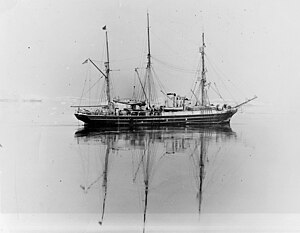 USS Bear (AG-29) in Antarctica, 1939
| |
| History | |
|---|---|
| Name | SS Bear |
| Owner |
|
| Port of registry | St. John's, Newfoundland |
| Builder | Alexander Stephen & Sons Ltd. [Dundee], Scotland |
| Launched | 1874 |
| Identification | Official Number: 66840 |
| Fate | Sold to U.S. government in 1884 |
| Name |
|
| Commissioned | 1885 |
| Decommissioned | 1944 |
| In service | 1884–1929,[1] 1939–1944 |
| Out of service | 1926–1938 (museum ship); 1944–1948 (laid up) |
| Fate | Sold to Canadian owners for sealing in 1948 |
| Notes | Wireless call sign for USRC Bear was "RCB".[2] |
| Name | SS Arctic Bear |
| Owner | Shaw Steamship Line |
| Port of registry | Halifax, Nova Scotia |
| Out of service | 1948–1961 (protracted refits); 1962 (restaurant conversion) |
| Fate | Sank in the Atlantic, 19 March 1963, under tow |
| General characteristics | |
| Type | Ice-strengthened auxiliary steamer |
| Displacement | 703 tons |
| Length | 198.5 ft (60.5 m) |
| Beam | 30 ft (9.1 m) |
| Draft | 18.8 ft (5.7 m) |
| Propulsion | 300 ihp (220 kW) compound steam engine, 1 screw |
| Range | Limited by water and provisions |
| Complement | 51 |
| Aircraft carried | Carried Barkley-Grow seaplane on Byrd Expedition III |
USS Bear was a dual steam-powered and sailing ship built with six-inch (15.2 cm)-thick sides which had a long life in various cold-water and ice-filled environments. She was a forerunner of modern icebreakers and had a diverse service life. According to the United States Coast Guard official website, Bear is described as "probably the most famous ship in the history of the Coast Guard."[3]
Built in Scotland in 1874 as a steamer for sealing, she was owned and operated from Newfoundland for ten years. In the mid-1880s, she took part in the search for the Lady Franklin Bay Expedition.[4] Commanded by Michael Healy of the United States Revenue-Marine, renamed the United States Revenue Cutter Service in 1894 (and one of the ancestor organizations of the United States Coast Guard), she worked the 20,000-mile (32,200 km) coastline of Alaska. She later assisted with relief efforts after the 1906 San Francisco earthquake.
Her services also included the second expedition of Admiral Richard E. Byrd to Antarctica, and again to the southernmost continent in 1941 to evacuate Americans at the beginning of World War II. She later served on patrol duty off the coast of Greenland for the United States Navy. Between some of these missions, she was a museum ship in Oakland, California, and starred in the 1930 film version of Jack London's The Sea-Wolf.
After World War II, Bear was returned to use again as a sealing vessel. Finally, in 1963, 89 years after she had been built, while being towed to a stationary assignment as a floating restaurant in Philadelphia, Pennsylvania, Bear foundered and sank in the North Atlantic Ocean about 100 nautical miles (190 km; 120 mi) south of Cape Sable Island, Nova Scotia, Canada.
- ^ Bear, 1885
- ^ "List of Revenue Cutters", WIRELESS TELEGRAPH STATIONS OF THE WORLD, INCLUDING SHORE STATIONS, MERCHANT VESSELS, U.S. REVENUE CUTTERS, AND VESSELS OF THE UNITED STATES NAVY. CORRECTED TO OCTOBER 1, 1910. U.S. DEPARTMENT OF THE NAVY. BUREAU OF STEAM ENGINEERING. WASHINGTON, D.C. U.S. GOVERNMENT PRINTING OFFICE : 1910, p. 59.
- ^ "United States Coast Guard (USCG) - Pacific Area".
- ^ United States. Revenue-Cutter Service (1898). Report of the cruise of the U.S. Revenue Cutter Bear and the overland expedition for the relief of the whalers in the Arctic ocean, from November 27, 1897, to September 13, 1898. Washington, D.C.: Government Printing Office. Retrieved 23 March 2014.